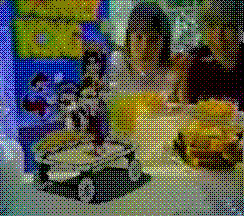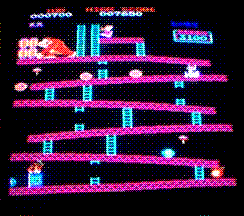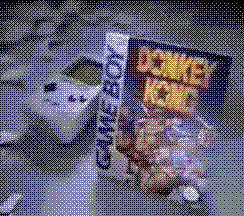Spotlight:
Donkey Kong Historia
|
Many of Nintendo's All Stars have been granted their due upgrades onto the Super Nintendo. Super Mario explored a fully fleshed-out World, and Link traversed numerous lands in Zelda III, but not until now was the Big N's mightiest ape given his time to shine. Far back in the golden era of arcades, when Space Invaders ruled the land, a young toy designer named Shigeru Miyamoto drew up plans for a novel arcade character. Fit to be deemed gigantic (Kong) and stubborn as a mule (Donkey), a stunning gorilla thrashed onto the scene. Donkey Kong rocketed Nintendo to superstardom as quick as it premiered with unprecedented earnings for the Japanese game manufacturer. Merchandise spanned the globe, cluttering retailers with plush figures, breakfast cereals, and a huge of assortment of wannabe ports on home systems. Kong was King!
With DK riding high and raking in the dough, Miyamoto and Co., under the watchful stewardship of Gunpei Yokoi, began development on the inevitable follow-up. This sequel cab put a clever spin on the original idea. It was Kong's son who now stood in the shoes of the hero. Donkey Kong Jr. cast Jumpman (an early incarnation of Mario) as the villain abductee, and it was up to DK Jr. to save his pop! Coleco's cartidge versions of both DK Jr. and the original Kong sold like hotcakes, as did the battery-powered tabletop editions. Donkey Kong 3 emerged in '83 to little fanfare as the global fascination with the giant ape began to fade away. That same year, the U.S. game industry fell into total collapse in epic fashion, whipping Coleco and Mattel straight out of the gaming biz. Americans waited two long years to hear a faint whisper of Nintendo knocking at their door.
|
  
Part Of Your Balanced Breakfast! The One That Started It All
An Epic Revival |
The Nintendo Entertainment System launched in the States in October of '85, singlehandedly rejuvenating interest in video games among Americans. A commendable home version Donkey Kong appeared alongside the NES in its early days, yet this was greatly overshadowed by Miyamoto's cutting edge project: Super Mario Bros. Thus began the rise of Super Mario as a household name as well as the continued fall into obscurity of DK. Kong reappeared in home ports of DK Jr. and DK 3, as well in an educational oddity called Donkey Kong Jr. Math, but a true successor series to the original smash hit was nowhere to be found. In 1992, Junior sneakily crawled his way back to the mainstream as a playable racer in Super Mario Kart to a chorus of children asking, "Who the heck is THAT?" As for the legendary Kong Sr., the tabloids assured us of his permanent retirement.
But then, the strangest thing happened. Donkey Kong for Game Boy defied the odds and managed to vastly improve on the original formula. DK returned with a fresh coat of paint and a swathe of new levels in an outing PPM defined creative and ingenious. Its use as a dominant promotional tool for the Super Game Boy accessory should have been a ginormous hint that Nintendo had bigger ideas for their original mascot, but few could imagine the possibilities. The reveal of Donkey Kong Country at CES Chicago this summer meant not only the triumphant return of DK, but further proof that you never can predict exactly what the Big N has up their sleeves. DKC, the 32-MEG beast from Rare, showcases the true power of the SNES with unreal graphics, lifelike animations, and monkey-tastic gameplay. On SNES, and surely on Ultra 64, Kong's future is bright.
|

[Article from the November 1994 Issue of PPM]
|

















